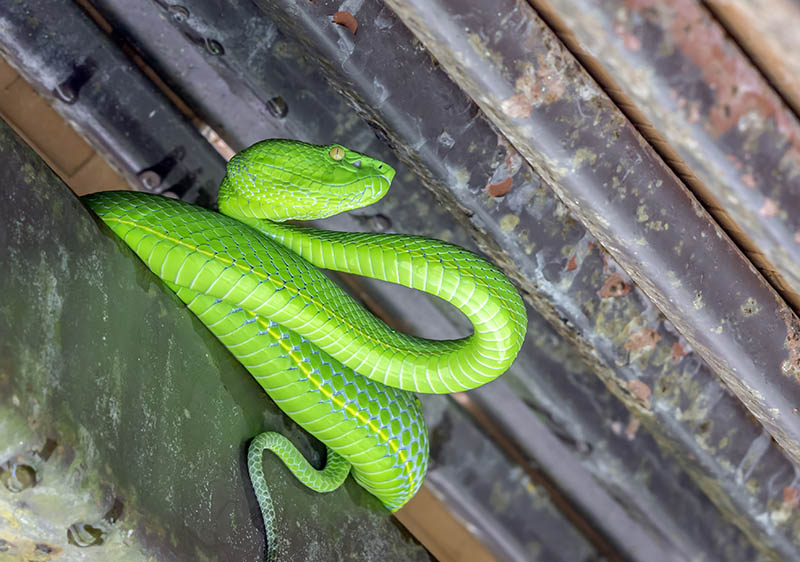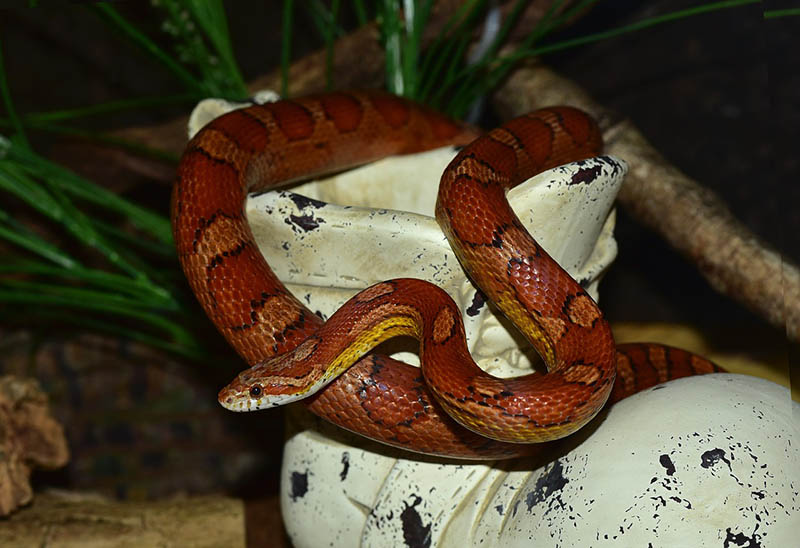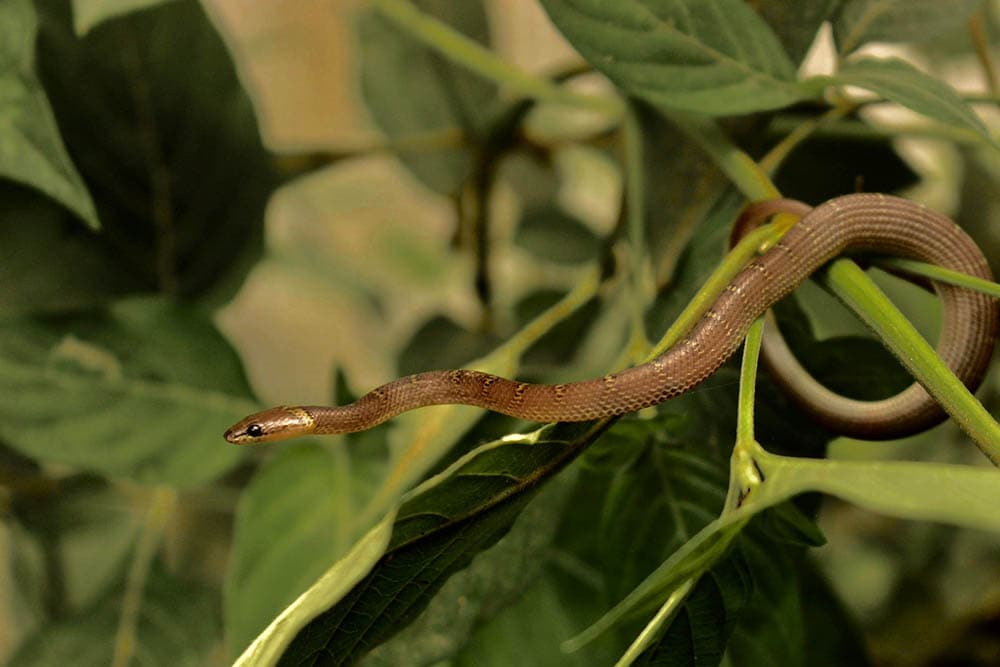Can Snakes Climb Stairs? What You Should Know
-

- Last updated:

If you live in a snake-ridden area, it’s natural to wonder whether these slithering creatures can climb stairs in search of food or warmth. Snakes remain a mystery to most people, and there are many misconceptions regarding what they can and cannot do.
So, can a snake climb stairs?
Yes, it can. Most snakes, including garden snakes, can climb trees, stairs, and brick walls with remarkable ease and speed. Because they cannot stick to surfaces, climbing smooth surfaces can be challenging but not impossible. Provided the snake has enough body length, it can push itself upward and climb your staircase to the very top.
Can a Snake Climb to the Upper Floors of My Home Through the Stairway?

Most snakes can climb textured surfaces, and your stairways are not an exception. However, stairs are difficult to climb, and a snake will not explore the upper floors of your home without sufficient incentive. If the target is worth it, most serpents will have the determination to achieve their objective. This includes tackling obstacles such as a staircase.
Stairways with carpeted flooring are the easiest to climb. A snake can climb easily because the carpet provides adequate grip. It’s more or less like climbing a rock with grass.
How Do Snakes Climb Stairs?
Snakes don’t like exploring new places. They are also not fans of close encounters with pets and humans. These slithering creatures will only climb your stairs if they are searching for food, warmth, safety, or a mate.
But do these limbless creatures climb staircases?
Snakes are expert climbers and climb rocks and trees when pursuing prey in the wild. They have a complex vertebrae system with up to 400 vertebrae that enhance their overall flexibility. Also, they have just as many ribs on the underside that protect their internal organs from potential damage.
Even though snakes crawl on their bellies, they have strong muscles that allow smooth, painless movements. The muscular force, coupled with the tough ventral scales on a snake’s skin, ensures easy gripping of any rough edges on surfaces.
Generally, snakes climb using concertina movement. It grips and anchors its body on one stair using the front part of its body and then uses the remaining section to push and pull itself up.
Can Snakes Climb Smooth Stairways?

If you have smooth stairways, a snake will likely not climb to the upper floors of your home. Smooth surfaces don’t provide the friction a snake needs to move.
Generally, snakes climb by expanding and contracting their muscles. The upper body needs a good grip on the ground to allow the serpent to pull and push up the rest of its body. If it has no friction with the ground, it cannot propel itself in any direction and will merely slither around randomly until it finds a textured surface.
Does this mean that snakes can’t move on tiles?
If you have a tiled stairway, whether or not a snake can climb up your stairs will depend on the texture of the surface. A snake may get the grip needed to climb if the tiles offer enough friction because of the grates and patterns. Even so, serpents can’t climb stairways floored with smooth tiles.
Tips to Stop Snakes From Trying to Get Into Your Home
Snakes, in general, including the venomous species, are suspicious of humans and would rather keep off their territories. However, this doesn’t mean they will not attempt to enter your home, especially when assured of warmth, food, or a mate.
If you don’t want to share your backyard or house with snakes, here are easy tips to deter these slithering creatures from roaming around on your property.
- Mow your lawn and trim bushes and trees
- Consider installing a snake-proof fence
- Remove bird feeders and other sources of food that attract birds, mice, and rats.
- Get rid of standing water from ponds, rain barrels, and birdbaths
- Keep pet food inside to dissuade rats and, by extension, deter snakes
- Remove log piles and junk in your garden where snakes can hide
- Seal holes or cracks that can give snakes entry into your house
- Spray your yard with natural snake repellants like naphthalene, sulfur, and ammonia
Frequently Asked Questions
Here are some frequently asked questions about snakes and stairs.
Can Small Snakes Climb Stairs?
For a snake to climb stairs, it must be long enough for a portion of its upper body to reach the next step. Smaller snakes that lack the length to reach the next step cannot climb stairs. On the other hand, longer serpents can scale several steps at a go when climbing up stairways.
Can Snakes Climb Concrete Stairways?
Snakes can move on concrete. Concrete surfaces offer some grip, although climbing up a concrete stairway can prove challenging for most snakes. Because snakes are great fans of energy efficiency, they will likely not attempt a task that proves overly challenging.
Can A Snake Jump Up Stairs?

If snakes make you freak out, it’s easy to imagine they can do all sorts of gymnastics. Fortunately, they are limbless, making it impossible to spring off the ground entirely. However, a snake from a coiled position can lunge forward at high speed. Even if the surface texture allows, a snake will likely not charge toward you in explosive strikes, especially when climbing stairs.
Can Snakes Climb Walls?
Snakes can climb walls, but not just any wall. Again, the serpent needs to grip the surface with its scales and push up the rest of its body. Brick walls have nooks and crannies, making them practical for snakes to climb. The grooves provide extra traction where the snake can curl its body and remain steady on the wall. However, snakes cannot climb smooth walls.
Where Can A Snake Hide In A House?
Snakes can hide inside a house around areas with less human activity. This may include under your oven, bed, or refrigerator. The serpent can also curl up inside a cabinet and only come out to feed. Snakes can even establish long-term nests in the crawl space, attic, basement, or garage in homes that provide consistent food supplies.
Final Thoughts
Snakes climb just as easily as humans walk. It’s in their nature, and moving up a stairway is not as hard for them as many would assume. While they can climb quickly, you are more likely to win in a race up your staircase.
Snakes climbing stairs to get into the attic is a common problem, especially in snake-prone areas. Often, these serpents are lured by the smell of rats. It is crucial to ensure your attic is clean, organized, and free of rats and mice infestations. This will ascertain that a snake has no reason to explore your interiors.
Furthermore, make your outdoors less charming to snakes. If mowing your grass does not seem to help, consider replacing the grass with hard gravel. It’s also a good idea to smooth out exterior walls and surfaces and ensure they offer minimal grip.
Featured Image Credit: Mee_Noi, Shutterstock
Contents



